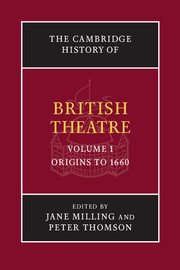Book contents
- Frontmatter
- PART I PRE-ELIZABETHAN THEATRE
- 1 From Roman to Renaissance in drama and theatre
- 2 Faith, pastime, performance and drama in Scotland to 1603
- 3 The Bible as play in Reformation England
- 4 Drama in 1553: continuity and change
- PART II ELIZABETHAN THEATRE
- PART III JACOBEAN AND CAROLINE THEATRE
- Works Cited
- Index
- References
1 - From Roman to Renaissance in drama and theatre
from PART I - PRE-ELIZABETHAN THEATRE
Published online by Cambridge University Press: 28 March 2008
- Frontmatter
- PART I PRE-ELIZABETHAN THEATRE
- 1 From Roman to Renaissance in drama and theatre
- 2 Faith, pastime, performance and drama in Scotland to 1603
- 3 The Bible as play in Reformation England
- 4 Drama in 1553: continuity and change
- PART II ELIZABETHAN THEATRE
- PART III JACOBEAN AND CAROLINE THEATRE
- Works Cited
- Index
- References
Summary
Roman remains: the Phantom limb
phantom limb, the sensation that an amputated limb is still present, often associated with painful paresthesia. (Syn. stump hallucination)
(Stedman’s Medical Dictionary, 26th edition)Patients recovering from amputations often report that during post-operative healing – in some cases long after convalescence is over – they feel twinges of pain or itching from the lost limb, an odd misfiring in the central nervous system and cerebral cortex indicating that life continues to haunt what is now clearly empty space. This phenomenon, a medical condition commonly known as a ‘phantom limb’, compounds the body's wistful remembrance with something less than material fact. It may be a useful condition to keep in mind as we approach the Roman theatrical tradition in Britain from a place and time as far removed as the present. Like a phantom limb, Roman drama in Britain continues to send signals of its once vital life long after all but stony remnants of its presence have disappeared, long after the vast civilisation that spawned and nurtured it passed on into history. Our experience of the Roman theatrical tradition, poignant, incomplete, perhaps suspicious, has its roots in that vibrant, vanished, phantom culture.
Today, in the early dawn of the twenty-first century, the rise and fall of the phantom Roman empire and its cultural dominion, spanning five hundred years of British history over two millennia ago, seem far-off events in a sequence hard to imagine, hard to suggest as even tangentially important to a modern history of British theatre. The past is passed by so easily. With the single blink of an eye, a contemporary theatre aficionado with interests in scripts, stages and costumes might quickly by pass whole centuries of Roman invasion, occupation and cultural colonialism.
- Type
- Chapter
- Information
- The Cambridge History of British Theatre , pp. 1 - 69Publisher: Cambridge University PressPrint publication year: 2004



